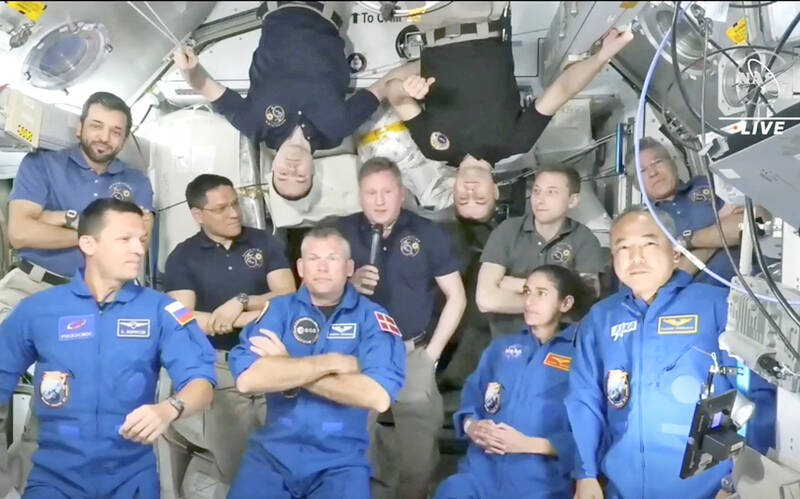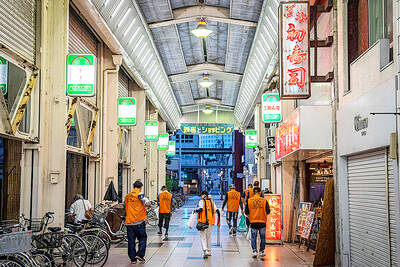Climate crises, nuclear Armageddon or a sudden meteor strike — it is clear humanity could do with Planet B — but first, we need to learn to reproduce safely in space, Dutch entrepreneur Egbert Edelbroek said.
Edelbroek’s firm, Spaceborn United, is pioneering space sex research, with the eventual aim of natural conception and birth in the partial gravity environment found on Mars.
The challenges of achieving safe space sex are galactic, but the ambitious Dutchman is confident he would see an extraterrestrial human child born within his lifetime.

Photo: AFP
“It’s important that the Earth and humanity can become a multiplanetary species,” Edelbroek said.
“If you want to have independent human settlements beyond Earth, and if you really want them to be independent, you also need to address the reproductive challenge,” he said.
Actual sexual intercourse in space presents many difficulties, chief among them the lack of gravity — a couple would drift away from each other — so Spaceborn United is first trying to conceive an embryo in space,” he said.
Starting with mice, before eventually moving to human sperm and egg cells, the firm has created a disc that mixes the cells together, with the aim of producing a viable embryo.
It is like a “space station for your cells,” said Aqeel Shamsul, CEO of the UK-based Frontier Space Technologies, which is working with Spaceborn on the project.
This embryo is then cryogenically frozen, to pause their development, but also to protect them during re-entry.
“It’s a lot of shaking, a lot of vibration, a lot of G-forces. You don’t want to expose embryos to this,” Edelbroek said.
Research is under way in simulated partial gravity laboratory conditions, but Edelbroek said a launch with mice cells was planned for the end of next year, with a timeline of “about five or six years” for the first launch with a human embryo.
However, that is only one small step. A giant ethical leap remains before such an embryo could be implanted back into an Earthling woman to give birth to the first child conceived in space.
“It’s a delicate topic. You’re exposing vulnerable human cells, human embryos, eventually, to the hazards of space, to radiation that is much higher than on Earth, to different gravity environments that embryos are never designed for,” Edelbroek said.
Such ethical issues are one reason why research into space reproduction has generally been left to private firms like Spaceborn, rather than NASA, which is queasy about spending tax dollars on such sensitive topics.
Edelbroek said his firm was the only one looking to develop a human embryo in space. Bodily fluids that are pulled down on Earth would be drawn upward in a low-gravity environment, posing several challenges for the human body.
“An adult body can handle some differences, but you don’t want to expose a growing, more vulnerable, fetus to these different variables. So you need to create the perfect environment first,” he said.
One new factor in space reproduction is the growth of space tourism, fueled by companies such as SpaceX and Virgin Galactic.
Couples on a space tourism flight might want to go down in history as the first to conceive, Edelbroek said, adding that he was consulting with the sector to make them aware of the risks.
Spaceborn’s research —which replicates the IVF process, but in space — is also helping people closer to home to conceive, he said.
The Dutchman said he had been forced to scale back his plans.
“We’ve gone from crazy ambitious to just very ambitious,” as the scale of the challenges became clear, he said.
Nonetheless, he is sure that a baby would be born in space within his lifetime.
“I expect to be at least 100 years old,” the 48-year-old said. “So that should give us enough decades to achieve that, absolutely.”
“Eventually, humanity — hopefully with us — needs to achieve childbirth in space,” he said.

The Venezuelan government on Monday said that it would close its embassies in Norway and Australia, and open new ones in Burkina Faso and Zimbabwe in a restructuring of its foreign service, after weeks of growing tensions with the US. The closures are part of the “strategic reassignation of resources,” Venezueland President Nicolas Maduro’s government said in a statement, adding that consular services to Venezuelans in Norway and Australia would be provided by diplomatic missions, with details to be shared in the coming days. The Norwegian Ministry of Foreign Affairs said that it had received notice of the embassy closure, but no

A missing fingertip offers a clue to Mako Nishimura’s criminal past as one of Japan’s few female yakuza, but after clawing her way out of the underworld, she now spends her days helping other retired gangsters reintegrate into society. The multibillion-dollar yakuza organized crime network has long ruled over Japan’s drug rings, illicit gambling dens and sex trade. In the past few years, the empire has started to crumble as members have dwindled and laws targeting mafia are tightened. An intensifying police crackdown has shrunk yakuza forces nationwide, with their numbers dipping below 20,000 last year for the first time since records

EXTRADITION FEARS: The legislative changes come five years after a treaty was suspended in response to the territory’s crackdown on democracy advocates Exiled Hong Kong dissidents said they fear UK government plans to restart some extraditions with the territory could put them in greater danger, adding that Hong Kong authorities would use any pretext to pursue them. An amendment to UK extradition laws was passed on Tuesday. It came more than five years after the UK and several other countries suspended extradition treaties with Hong Kong in response to a government crackdown on the democracy movement and its imposition of a National Security Law. The British Home Office said that the suspension of the treaty made all extraditions with Hong Kong impossible “even if

Former Japanese prime minister Tomiichi Murayama, best known for making a statement apologizing over World War II, died yesterday aged 101, officials said. Murayama in 1995 expressed “deep remorse” over the country’s atrocities in Asia. The statement became a benchmark for Tokyo’s subsequent apologies over World War II. “Tomiichi Murayama, the father of Japanese politics, passed away today at 11:28am at a hospital in Oita City at the age of 101,” Social Democratic Party Chairwoman Mizuho Fukushima said. Party Secretary-General Hiroyuki Takano said he had been informed that the former prime minister died of old age. In the landmark statement in August 1995, Murayama said